Guardbridge geothermal technology demonstrator project: feasibility report
Report of the study exploring the potential of a geothermal district heating system accessing hot sedimentary aquifer resources underlying Guardbridge, Fife.
4. Heat Supply
4.1 Predicted aquifer properties at wells
An estimate of aquifer quality, specifically rock permeability and downhole rock temperature, is required for each target interval to predict flow rate and water temperature at the surface for the different well completion designs.
Town Rock Energy Ltd ( TRE) have previously constructed a regional database of petrophysical properties of sandstones in the target intervals. This draws on all publicly available deep wells in the Fife and Firth of Forth areas (Section 2.3). It carries significant uncertainty. For example, the Knox Pulpit Formation, which is generally agreed as the best target, is only found at depth in one well. However, experience in generating similar databases for oil and gas exploration has shown that the approach is a reasonable guide at this stage of evaluation.
For each well, the primary and secondary target intervals are identified with a depth range. The TRE depth versus porosity relationship is used to estimate an average porosity for the target sandstones. The porosity value is used to estimate the average permeability using a relationship determined from core plug measurements. The porosity-permeability relationship was developed prior to this study by TRE, based on new analysis of core data held by the British Geological Survey and earlier published data for the wells in Fife and the Firth of Forth area.
The average permeability for an interval is multiplied by the aquifer thickness penetrated in the well to give a total permeability for the target. There is large uncertainty in this estimate. At any one depth, the range in porosity might be 6 - 15 %, which gives a permeability range of 0.1 - 10 mD (two orders of magnitude) (0.013 -0.013 m/d in units of hydraulic conductivity). To simplify the evaluation, the most likely estimate has been used, except where the rocks are likely to have higher permeabilities (e.g. in the Knox Pulpit and Kinnesswood formations and in the zone across the fault in GB-2, where two scenarios are evaluated).
TRE have used published temperature depth plots for the Midland Valley (Gillespie et al., 2013) and verified the trend by reviewing the raw well log temperature and circulation data in the prior petrophysics study.
4.1.1 Well GB-1
This well (Fig. 3.7) has a thin Scone Sandstone Formation target which has probably been up to 4000 m deeper at maximum burial before being uplifted. Taking an optimistic porosity of 11 % from a trend that does not allow for the deeper burial effects gives 1 mD (0.0013 m/d) of permeability and so 30 mDM (0.039 m 2/d) of permeability thickness (transmissivity) for the target interval. If the burial history is assumed to degrade porosity then it will be closer to 6%, with negligible permeability. There are secondary, tighter, targets in the overlying Glenvale Sandstone Formation, which may offer another 150 mDM. The volcanic rocks below 700 m in the GB-1 well may have reasonable flow rates, based on some shallow potable water wells in Dundee where natural fractures and porosity deliver 5 - 15 l/s of water. This cannot be tested without drilling. Temperature in the primary target interval is estimated at 24 oC.
4.1.2 Well ES
All rocks below 600 m could contribute to flow in this well. Primary targets are found at 700 - 800 m in the Kinnesswood and Knox Pulpit Formation and 1000-1050 m in the Glenvale Sandstone Formation (Fig. 3.8). Porosities gradually decrease over the target intervals from 11% in the Kinnesswood Formation to 7 % in the Scone Sandstone Formation. Permeability decreases from 1 mD to 0.05 mD (0.0013 to 0.000066 m/d), although the Knox Pulpit Formation may see 10 mD on average (0.013 m/d), based on the quality seen in outcrop. This gives permeability thicknesses of 100-1000 mDM in the primary target of the Kinnesswood/Knox Pulpit aquifer and 200 mDM over all the remaining intervals. This well has a significantly higher chance of achieving natural flow from the rocks than GB-1. Temperature in the primary target interval is estimated at 27 oC.
4.1.3 Well GB-2
This deviated well crosses the Dura Den Fault (Fig. 3.9). The thickness of the fault damage zone is estimated (see section 3.1) and the better quality Kinnesswood/Knox Pulpit aquifer is also present in the fault damage zone. The interval is estimated to have a porosity of 12 % and a permeability of 10 mD (0.013 m/d), though natural fractures in the fault zone could enhance this to an average of 100 mD (0.13 m/d). Two alternatives are evaluated: the sandstone in the primary target has 2200 mDM, or with the addition of open natural fractures in the fault damage zone, there may be over 10,000 mDM. There is an alternate reduced flow model arising from the fault acting as an inhibitor of flow due to cementation from fluids, which reduce the rock porosity and permeability. The deeper zones in this well away from the fault zone are not predicted to make a significant contribution. Temperature in the primary target interval is estimated at 24 oC.
4.2 Well completion options and performance
Two alternative well designs for extracting heat from the subsurface have been evaluated: using a Heat Pump and by direct Aquifer Production.
A heat pump design will circulate water down a casing string which is run to the bottom of the well. Water is warmed to rock temperatures and then brought to surface via plastic tubing inside the casing. All intervals are cased off and there is no production of aquifer water at the surface. This is essentially similar to a Ground Source Heat Pump but at greater depth. To recover economic amounts of energy from heat pump wells, there is a balance between the rates of circulation, heating within the well tubing, and cooling as the water comes to the surface through decreasing rock temperatures.
An aquifer production design produces water from the rocks directly and brings it to surface with the aid of an Electric Submersible Pump ( ESP) to allow for varying drawdown on the reservoir. These wells have a casing string isolating the shallow geology and then a protective slotted liner to reduce the risks of hole collapse and sand production from the aquifer interval as the pressures on the formation are reduced. The ESP will be run on production tubing or plastic pipe to the shallow casing shoe. There is a balance in aquifer production wells between the drawdown required to achieve higher flow rates, the increasing risk of sand production at high drawdowns, and the power required to drive the ESP. There are also considerations of well sustainability at higher flow rates, both for pressure support from the formation and for heat.
4.2.1 Well GB-1 design
An aquifer production well at GB-1 has a very low predicted flow rate due to the limited permeability thickness. Producing at a drawdown equivalent to a vacuum across the rock face produces 0.6 l/s flow which is an order of magnitude too small. Therefore, GB-1 is not a viable aquifer producer.
A heat pump well at GB-1 can only achieve small increases in temperature of about 1-3 oC at circulating rates of 1 to 5 l/s. The downhole temperature is too low and the circulation too fast to achieve sufficient heating. Figure 4.2 shows the temperature profile in the well at different circulation rates and input temperatures. GB-1 is not a viable heat pump well.
Fig. 4.1: Model temperature results for heat pump well completion at GB1.
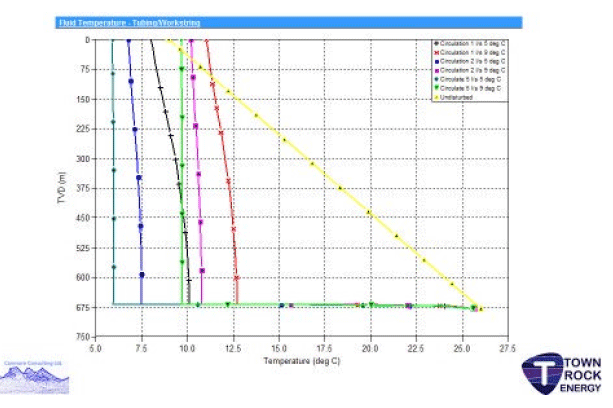
4.2.2 Well GB-1 design (deeper option)
Fig. 4.2 Model temperature results for heat pump well competion at GB1 at 2500 m depth.
Well GB-1 enters volcanic rocks at about 700 m below the ground surface and these rocks can be expected to be present to a depth of about 2500 m (Fig. 3.3 and 3.7). A heat pump circulating well, with a pump located at 2500 m, has been modelled and predicts a rock temperature of 72 oC at the base of the well. Figure 4.2 shows well temperature profiles at different circulation rates and input temperatures for a heat pump design. At low circulation rates of 1 l/s, fluid temperatures of 50 oC can be achieved at well bottom, but there is significant cooling because the fluid comes to the surface to about 17 oC. At higher circulation rates, downhole temperatures are lower (20 oC for a circulation rate of 5 l/s), but cooling is less and reasonable surface output temperatures about 5 oC higher than input temperatures can be achieved. Optimising tubing size and insulation, well rates and input temperatures can all influence performance. Circulation at 8 l/s to a depth of 2500 m in 114 mm pipe will give a surface temperature increase of 5 oC between input and output, where input temperature is between 5 oC and 9 oC. GB-1 deeper option may be viable as a deep circulating heat pump well.
Fig. 4.2: Model temperature results for heat pump well competion at GB1 at 2500 m depth.
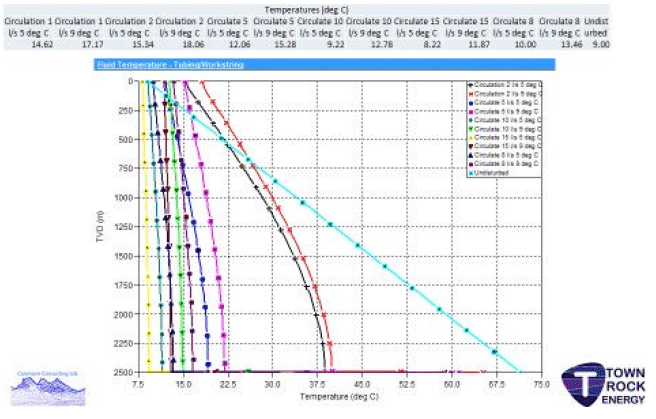
4.2.3 Well ES design
An aquifer production well at ES has very low flow rates unless the higher expected permeability model is used. In the 1000 mDM case, a flow rate of 5 l/s is achievable with a 20 kw ESP, giving 28 oC water temperature at the well head. There is insufficient rock quality to give higher rates of flow. ES may be a viable aquifer producer at low rates, but with the impact of additional costs attributed to the well's off-site location and the risk of lower productivity, it is not considered further. ES as a heat pump circulating well has similar characteristics to GB-1. It is too shallow to give sufficient temperature increases at the rates required. ES is not a viable heat pump well.
Fig. 4.3: Model output temperature results for an aquifer production well at GB2 with tabulated permeabilities and flow rates.
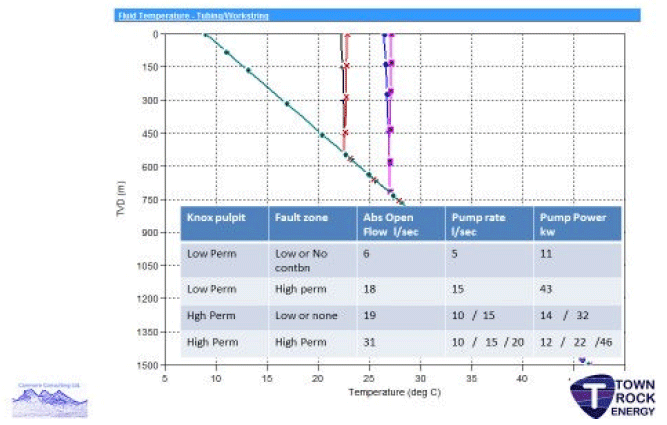
4.2.4 Well GB-2 design
GB-2 has not been considered as a heat pump circulating well, as there is no value in having a deviated well with this design. An aquifer production well can realise potentially economic flow rates because the Kinnesswood/Knox Pulpit aquifer and the fault damage zone can both have a positive effect on flow rate. A low permeability will yield 5 l/s flow rates with an 11 kw ESP. There are several combinations of Kinnesswood/Knox Pulpit and fault damage zone permeabilities that can deliver a flow rate of 15 l/s flow with an ESP power in the range of 22 - 43 kw. There is scope for flow of 20 l/s or higher, but at power inputs greater than 45 kw for the ESP. Output temperature will be between 23 oC and 27 oC, depending on the source of the dominant flow. GB-2 is a potentially viable aquifer production well.
Figure 4.3 shows the temperature profiles in the well for different pump rates for production and from two depths, equivalent to the Kinnesswood/Knox Pulpit aquifer and the fault damage zone.
Fig. 4.4: Model output temperature results for an aquifer production well at GB2 with tabulated permeabilities and flow rates.
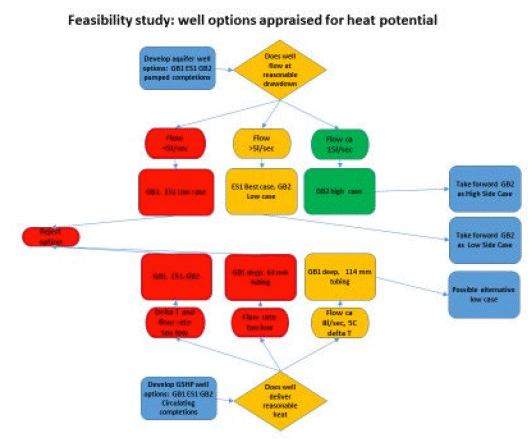
The flow diagram (Fig. 4.4) summarises the options and conclusions of the completion design, and the flow and temperature modelling with regard to each well location. The GB2 deviated well is taken forward for well design and cost estimation with two flow rate scenarios: 5 and 15 l/s.
4.3 Well design and drilling
This section addresses the construction of the GB2 well (Fig. 4.5). Appendix A includes options for drilling wells GB1 and ES1. Well GB2 would be a deviated shallow well that aims to drill through the Dura Den Fault to achieve flow from the intersection of the fault damage zone and the Knox Pulpit and Glenvale Sandstone formations. The total depth of the well is planned to be 1000 - 1200 m.
Fig. 4.5: Schematic lithological column and casing design for GB-2.
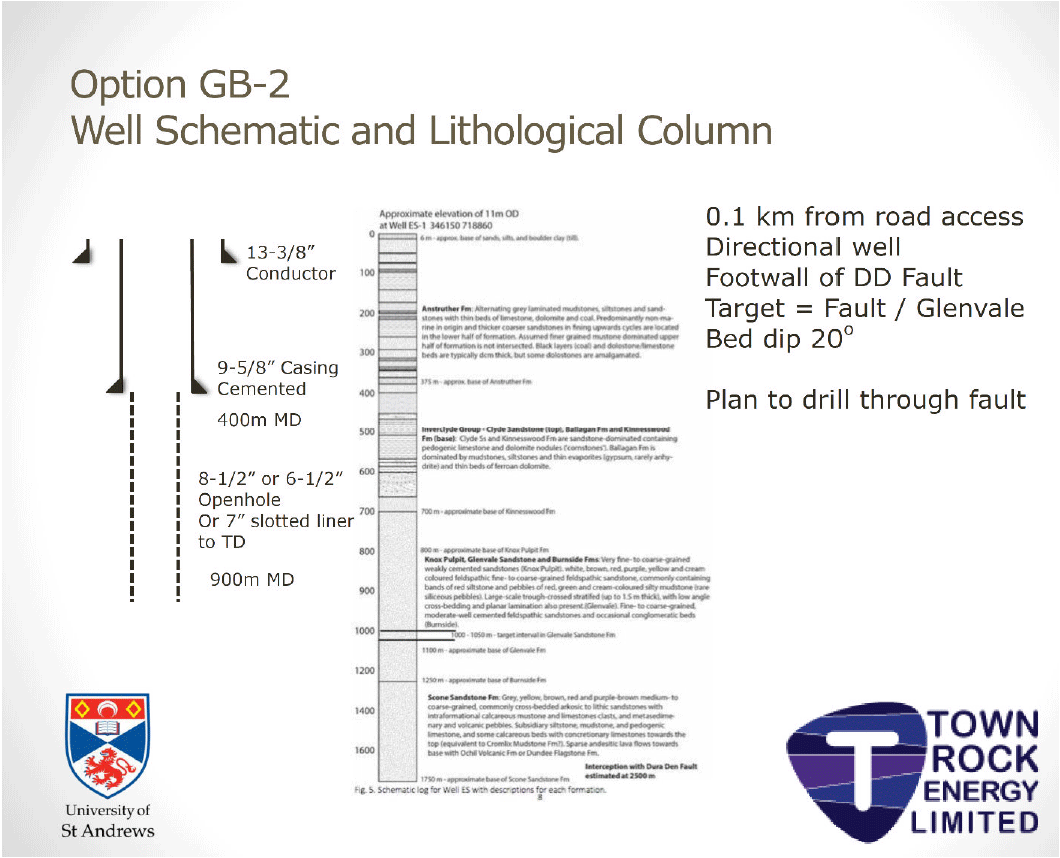
A conductor is required to get into hard rock through the surficial glacial and shore deposits. This is estimated to be 10 - 20 m and would be driven by the size of the other casing strings. The directional path would have to start at a true vertical depth ( TVD) of 200 m, increase to 20 o of inclination by 400 m depth, and up to 60 o of inclination by 800 m. The directional planning has not been developed in any detail at this point. It is possible that the well site may change location due to ongoing building development at Guardbridge and any reconnaisance geophysical surveys undertaken as part of Phase 2, which would identify the fault location, orientation and fault damage zone in more detail. The final choice of the GB-2 well location will be influenced by the required space to establish a constant deviation angle before entering the fault damage zone. A 9 5/8" casing would be set between a measured depth ( MD) of 400 - 800 m; this would be cemented to the surface and well control equipment could be installed.
The next hole section is through the target intervals and will include coring runs and logging; this may require further directional drilling, at least with stabilisers to hold the angle. Cores would be taken to allow measurements of porosity and permeability before the drilling and logging are complete. There is a possibility that logging and coring will demonstrate that the well is not capable of producing sufficient flow to be economic. The drilling could be suspended at this point, for the so-called "dry-hole" cost.
If, based on core and logs, the well has aquifer production potential, then flow rates will need to be tested. A full test will require installation of an ESP to achieve drawdown. With increasing drawdown there is an increased risk of sand production or well bore collapse, which would compromise the test and may require re-drilling prior to operating for long term production. Hence, it is recommended that any decision to test should be seen as a decision to complete the well for production. A slotted liner will be run to the well total depth to protect against wellbore collapse and mitigate sand production. The ESP would be run within steel pipe or plastic and once installed, the drilling rig would be demobilised as flow testing can be undertaken without the rig. Water clean-up, or capture and disposal, will be required in the test period and extensive water and particulate geochemistry would be conducted during this stage. Figure 4.6 summarises a decision tree for the development of well GB-2.
4.4 Well costs
The size and capability of the rig required to drill a deviated well determines the daily costs. An undersized rig, or a rig that is reaching its limitation, will lead to more non-productive time (rig breakdown time), issues with torque and drag on reaching the maximum depths, and may have to stop before reaching the objective or be unable to run or lift casing. After discussions with a number of operators for this well, a 100 tonne rig capable of 24 hour operations, drilling with a closed loop mud system and with well control equipment, is recommended.
Fig. 4.6: Decision flow chart for the completion of GB-2 well.
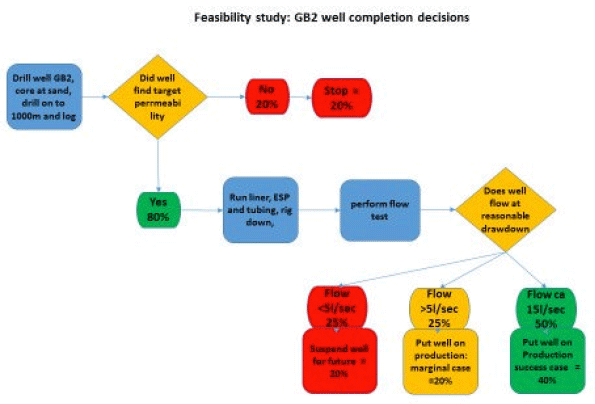
Cost estimation is based around a time versus depth curve for the well which fixes the costs associated with daily rates, such as the rig rental and crew, and directional drilling. The time depth curve (Fig. 4.7) assumes that the 9 5/8" casing is set at 400 m. Shifting it down to accommodate directional work will shorten the lower hole section and the length of liner required. The curve shows a total depth of 1000 m; extending the depth to 1200 m will produce a small increase to the total cost. The time required includes rig mobilisation and demobilisation. Consumable costs, such as casing, mud and fuel oil, have been included based on current industry rates. Service costs, such as wireline logging and coring, are also based on current onshore rates, although there is little recent experience in Scotland. Costs include contracting a drilling supervisor and drilling engineer for the duration of the well. Provision has been made in the costs for mud disposal.
Costs have not included well planning in the next stage, for which a provision of at least £50,000 is recommended. Costs have not included provision for site security, a health and safety adviser or the provision of utilities (other than rig fuel), as this is all assumed to be available within the Guardbridge site.
The well costs have been independently reviewed, but nevertheless carry a large uncertainty at this stage, as there are no offset data for drilling performance, no certainty that the high angle well trajectory can be achieved at shallow depths, and no recent experience of drilling near environmentally sensitive areas. Dry hole cost is £900,000 with a P90 - P10 range of £750,000 to £1,100,000. Production well cost is £1,100,000 with a P90 - P10 range of £900,000 to £1,300,000.
Fig. 4.7: Time-depth curve for well GB-2 with a TD of 1000 m ( MD).
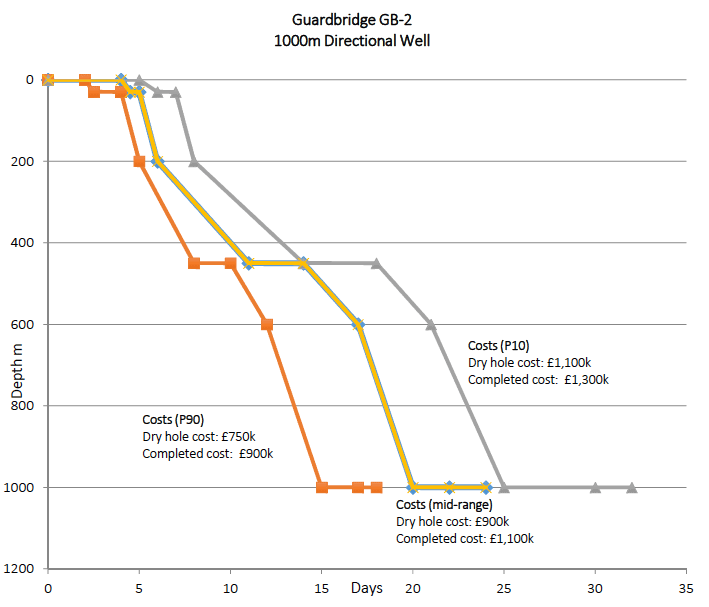
4.5 Well risks and other drilling options
An initial risk register (Table 4.1) has been compiled for wells at Guardbridge. All wells have similar risks except GB-2, which has additional risks with the directional drilling and drilling across the Dura Den Fault.
4.5.1 Lower cost drilling options
Other drilling options have been reviewed and offer both opportunities and risks. There is an opportunity to progress costing and design of a well similar to GB-2, but using a minerals slant drilling rig. This would use a slanted mast in order to eliminate the directional work, and drill a straight slanted hole across the fault and through the target zones. It would eliminate the costs associated with directional drilling and a higher specification rig, but would increase drilling time and is suited to a smaller hole size. The drilling angle is likely to be limited to 20 o, so there may be a trajectory that could test the geology and the fault, but it is not possible to drill the higher 60 o angle well proposed by GB-2 with a slant rig. It would be possible to recover core for the whole well bore below installing the surface casing (i.e. potentially through the fault zone and target horizons). It would also be possible to acquire some wireline log data, but flow testing may not be possible or would be very restricted by the small hole size. The well could not be completed as a producer. It is anticipated that the costs may be in the region of £250,000 -£450,000. This would need to be further investigated to confirm costs and review associated risks, especially with regard to well control.
Table 4.1: Risks associated with well development.
| Risk / Hazard |
Consequence |
Control Measures |
|---|---|---|
| Losses to unconsolidated sands |
Formation collapse; loss of mud |
Mud additives, offset data research required. Higher risk for GB-2 |
| Hard formations |
Vibration and damage to equipment; |
Offset data research required; further design on bits and drill string design |
| Unconsolidated target zone |
Liner will need to be cemented and perforated; |
Formation strength information; offset data research required Potential contingency of cemented liner and perforation. |
| Caverns |
Major losses; |
|
| Water influx |
Need heavier mud and fluid; |
Confidence in pressures for each formation. |
| Variable drill rate |
Damaged bits and/or lost equipment in hole; higher costs |
Bit and drill string design |
| Drilling through faults |
Formation collapse; loss of mud; |
Geophysical survey data through the fault and formations. Higher risk for GB-2 |
| Collapse of borehole during testing and/or production |
No access to clean out borehole at a later date |
Install slotted liner to prevent borehole collapse. |
A geotechnical drilling company have proposed drilling a probe well of 120 mm diameter to 600 m with air drilling. This would cost less than £100,000, assuming no casings would be required and that drilling could be done with air/foam drilling. This would be a vertical well and would therefore recover less than optimal amounts of data. It may be considered as an option to test the geology on either side of the fault, for example to test the depth to the Ochil Volcanic Formation on the footwall (on-site) or to test the depth to the top of the Knox Pulpit Formation and its thicknesses on the hanging wall (off-site).
4.5.2 Other capital costs: water disposal
In the event of a successful drilling operation with economic flow rates, well GB-2 would be put on long term aquifer production. This requires disposal of the produced water. Three options have been identified:
- Inject the water back into the aquifer
This is used in some Danish projects, but it is not the case at Southampton. Injection can maintain aquifer pressure, though there are uncertainties about this until the geology is better understood. Injection water will need to be placed some distance from the producer to prevent early thermal breakthrough of the cooler injected water to the producer. There is greater uncertainty about injection into a well than productivity. The production well can flow with a significant drawdown, but it is more difficult to inject at a significant overpressure. Issues include pump power, formation breakdown (fracturing), and controlling solids in the injected fluid. Injection wells will generally require more frequent intervention and downtime. It may be necessary to have two injection wells to protect against extended inoperation of the producing well. Finally, an injection well will have similar costs to a producer and may require a surface linkage to pumps.
- Dispose of the water into the sea
The Southampton scheme disposes of its water to sea. The complexity and feasibility of doing this at Guardbridge depends on water quality, and we assume that the aquifer water will be partly saline, and possibly more concentrated than sea water. If settlement, filtration and dilution can be used to passively treat the water then a settling lagoon equivalent to an Olympic swimming pool would be required to handle 15 l/s of produced water. Environmental concerns are dealt with in Section 11.
- Clean and recycle the water locally
The potential for treating the water and recycling it locally is worth investigating. There are water requirements on site and filtration to remove particulates, plus chlorinaton, could be necessary and sufficient treatments to produce potable water, although further desalination treatments are required for conductivities above 5000 s (pers. commun., Culligan ( UK) Ltd). Relevant technology from Culligan ( UK) Ltd includes two OSFY 48 or 54 filtration units and a GAC filter that use 10W of power and are therefore inexpensive to run. To de-salinate, vacuum membrane distillation can be integrated into a geothermal energy plant to reduce the operational costs.
Cost estimates for any water treatment, in the absense of a re-injection well, are very uncertain, but in the range of £250,000 to £500,000. Desalination has much higher power costs and creates a residual brine waste, therefore it may be uneconomic and unmanageable at the Guardbridge site.
4.5.3 Well life operation and repair costs
Operating expenditure for the well is limited to the power required to run the ESP. This varies for different scenarios, which are addressed in the economic summary. If used, the passive water treatment plant will have a small operational expenditure for the disposal of solids and it is assumed that this will be part of the overall Guardbridge site costs and an estimate is not provided.
Periodic well interventions to clean out solids and to replace the ESP are very difficult to forecast. Typically, in oil fields with higher temperatures and variable rates, ESP's have lifetimes of 18 months, but a range of 1 month to 20 years. The Guardbridge downhole pump will have relatively benign operating conditions. The only relevant recent experience is for an ESP in a geothermal well in Copenhagen which has operated for 12 years at 60 l/s, and has been replaced primarily due to build-up of dirt in the well over this period. The cost of a well intervention to replace tubing is also difficult to estimate as this requires a fuller understanding of the well design and geology, but one assumption is that it will not require a 100 tonne rig as the tubing can be removed with a light rig or crane.
4.6 Well engineering activities in Phase 2
To progress to a ready-to-drill well, there will be several activities:
1. Conduct a geophysical survey of Guardbridge and surrounding area to attempt to remotely image the aquifer targets and the fault behaviour, and thereby reduce the uncertainty in well trajectory for a deviated GB-2 well.
2. Revise the well trajectory based on increased geological knowledge and choice of drilling rig and review directional drilling constraints.
3. Review available (offset) well data on rate of penetration, drilling fluid and well control to better constrain design and costs.
4. Evaluate whether drilling using a "minerals" slant rig or shallow "probe" boreholes will add value or significantly reduce uncertainty in the final well.
5. Finalise the optimal design for well completion.
6. Produce economic model (costs and re-sale value) for on-site water recycling or disposal-to-sea options, and finalise decisions on water management.
7. Expand and manage the exploration and operation risk register.
8. Complete documentation and licensing applications for DECC, SEPA, SNH, Scottish Water and the Health and Safety Officer.
9. Provide Health and Satefy Executive ( HSE) inspectors with detailed drilling plans and risk assessments.
10. Procure rig and other services.
It is estimated that it could take 6 months to reach Stage 7, at which point a case for drilling and rig procurement would be complete. Estimates of time to complete procurement and final well planning is not estimated here.
Contact
There is a problem
Thanks for your feedback